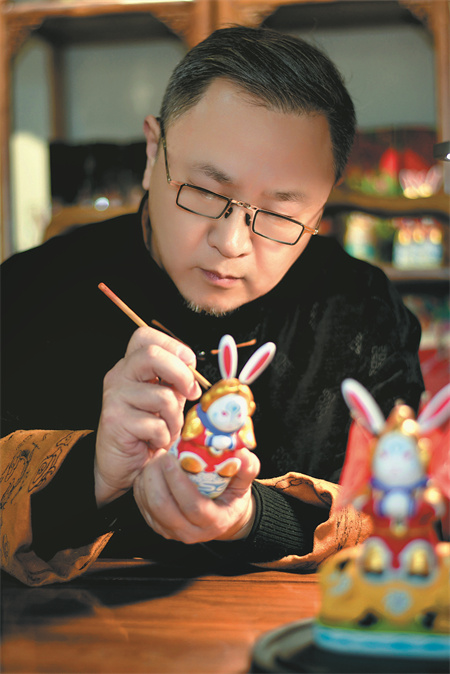

According to the legend, the people of Jinan were once plagued by an illness for which they had no cure. In their desperation, they turned to the gods for help. The rabbit god, residing in the moon palace, heard their plea and descended to Earth with a medicine that could heal the people.
The immortal proceeded to pour the elixir into 72 springs throughout Jinan, and as people drank the water, the epidemic was eradicated and the people of Jinan were saved.
As a result, a folk tradition emerged in Jinan where citizens worship a clay rabbit god named Tuzi Wang during Mid-Autumn Festival, which is now considered a symbol of safety and good health in the city.
Yang heard about the tales in childhood and wanted to get one, but he never found it. Then, after helping his classmate to repair a colored mud piece, he realized that he could make one on his own.
In 2004, Yang noticed there was a competition to develop a souvenir for Jinan which needed to represent local culture and be portable. Yang thought that the rabbit god fit all the qualifications and spent a whole month making one from scratch.
He won top prize at the competition, which encouraged him to quit his job as an interior designer and devote himself to making effigies of the rabbit god.
Spring into action
There were not many clues left about what the traditional lord rabbit looked like. After several dead ends, Wang found a book about folk toys in Shandong which recorded their myths, production procedures and photos of them. He was thrilled.
He learned from the book that, at its peak, there were around 30 stores across Jinan making models of the lord rabbit, and each one had its own unique features. However, the skill had been fading since the 1960s.
"I didn't want to replicate the previous ones recorded in the book, but to find my own style," he says.
Yang made a plan to create 72 rabbit statues to represent the 72 natural springs in Jinan and has finished several already. On the basis of the classic pattern, Yang incorporates elements of each location, including the spring water, landscape and poems, as well as the spring's name, in the character.
According to Yang, the raw material to make rabbits is usually mud taken from the Yellow River. The water from the Yellow River will naturally clear the sand and leave the fine river mud, which has good adhesion and strong plasticity with no impurities.
It takes a dozen procedures and over 30 steps for Yang to make a lord rabbit, from molding the mud to painting the patterns, and he also needs time to design and modify the piece.
Yang has added a new procedure, that of firing in a kiln. "I've learned pottery craft and that procedure is similar to the way the terracotta warriors were made," he says.
Yang worked for seven to eight hours to make it firm.
"It can absorb the water in the pigment and make the color effect better," he explains.